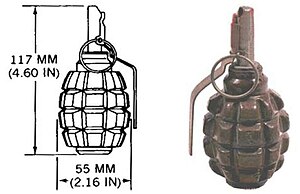F-1 grenade (Russia)
| F-1 anti-personnel hand grenade | |
|---|---|
 F-1 Hand grenade | |
| Type | Hand grenade |
| Place of origin | Russia |
| Specifications | |
| Mass | 600 g |
| Length | 130 mm |
| Diameter | 55 mm |
| Filling | TNT |
| Filling weight | 60 g |
The Soviet F-1 hand grenade, nicknamed the limonka (lemon [grenade]) is an anti-personnel fragmentation, or 'defensive' grenade. It contains a 60 gram explosive charge (TNT). The total weight of the grenade with the fuze is about 600 grams. The UZRGM fuze is a universal Russian type also used in the RG-41, RG-42, and RGD-5 grenades. The fuse time is 3.5 to 4 seconds.
The F1 was introduced during WW2 and subsequently redesigned post-war. It has a steel exterior that is ribbed to generate fragmentation upon detonation and to prevent hands from slipping. The distance the grenade can be thrown is estimated at 30-45 meters. The radius of the shrapnel dispersion is up to 200 meters (effective radius is about 30 meters, by some sources ).
The F1 grenade has been supplied to various foreign countries over the years, including Iraq and other Arab nations, and there are different production variations according to country of origin (in terms of finish, markings and spoon/lever design). Though obsolete and no longer in production, it can still be encountered in combat zones.
